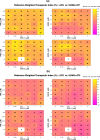COMBImage: a modular parallel processing framework for pairwise drug combination analysis that quantifies temporal changes in label-free video microscopy movies
- PMID: 30477419
- PMCID: PMC6257977
- DOI: 10.1186/s12859-018-2458-x
COMBImage: a modular parallel processing framework for pairwise drug combination analysis that quantifies temporal changes in label-free video microscopy movies
Abstract
Background: Large-scale pairwise drug combination analysis has lately gained momentum in drug discovery and development projects, mainly due to the employment of advanced experimental-computational pipelines. This is fortunate as drug combinations are often required for successful treatment of complex diseases. Furthermore, most new drugs cannot totally replace the current standard-of-care medication, but rather have to enter clinical use as add-on treatment. However, there is a clear deficiency of computational tools for label-free and temporal image-based drug combination analysis that go beyond the conventional but relatively uninformative end point measurements.
Results: COMBImage is a fast, modular and instrument independent computational framework for in vitro pairwise drug combination analysis that quantifies temporal changes in label-free video microscopy movies. Jointly with automated analyses of temporal changes in cell morphology and confluence, it performs and displays conventional cell viability and synergy end point analyses. The image processing algorithms are parallelized using Google's MapReduce programming model and optimized with respect to method-specific tuning parameters. COMBImage is shown to process time-lapse microscopy movies from 384-well plates within minutes on a single quad core personal computer. This framework was employed in the context of an ongoing drug discovery and development project focused on glioblastoma multiforme; the most deadly form of brain cancer. Interesting add-on effects of two investigational cytotoxic compounds when combined with vorinostat were revealed on recently established clonal cultures of glioma-initiating cells from patient tumor samples. Therapeutic synergies, when normal astrocytes were used as a toxicity cell model, reinforced the pharmacological interest regarding their potential clinical use.
Conclusions: COMBImage enables, for the first time, fast and optimized pairwise drug combination analyses of temporal changes in label-free video microscopy movies. Providing this jointly with conventional cell viability based end point analyses, it could help accelerating and guiding any drug discovery and development project, without use of cell labeling and the need to employ a particular live cell imaging instrument.
Keywords: Drug combination analysis; Glioblastoma multiforme; Label-free; MapReduce; Parallel image processing; Systematic parameter optimization; Therapeutic synergy; Time-lapse video microscopy.
Conflict of interest statement
Ethics approval and consent to participate
Not applicable.
Consent for publication
Not applicable.
Competing interests
The authors declare that they have no competing interests.
Publisher’s Note
Springer Nature remains neutral with regard to jurisdictional claims in published maps and institutional affiliations.
Figures










References
-
- Solmesky LJ, Khazanov N, Senderowitz H, Wang P, Minassian BA, Ferreira IM, Yue WW, Lossos A, Weil M, Kakhlon O. A novel image-based high-throughput screening assay discovers therapeutic candidates for adult polyglucosan body disease. Biochem J. 2017;474(20):3403–20. doi: 10.1042/BCJ20170469. - DOI - PMC - PubMed
MeSH terms
Grants and funding
LinkOut - more resources
Full Text Sources

